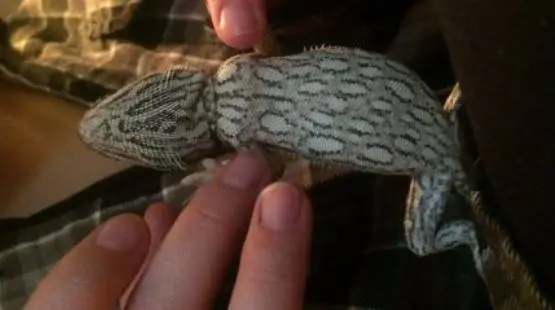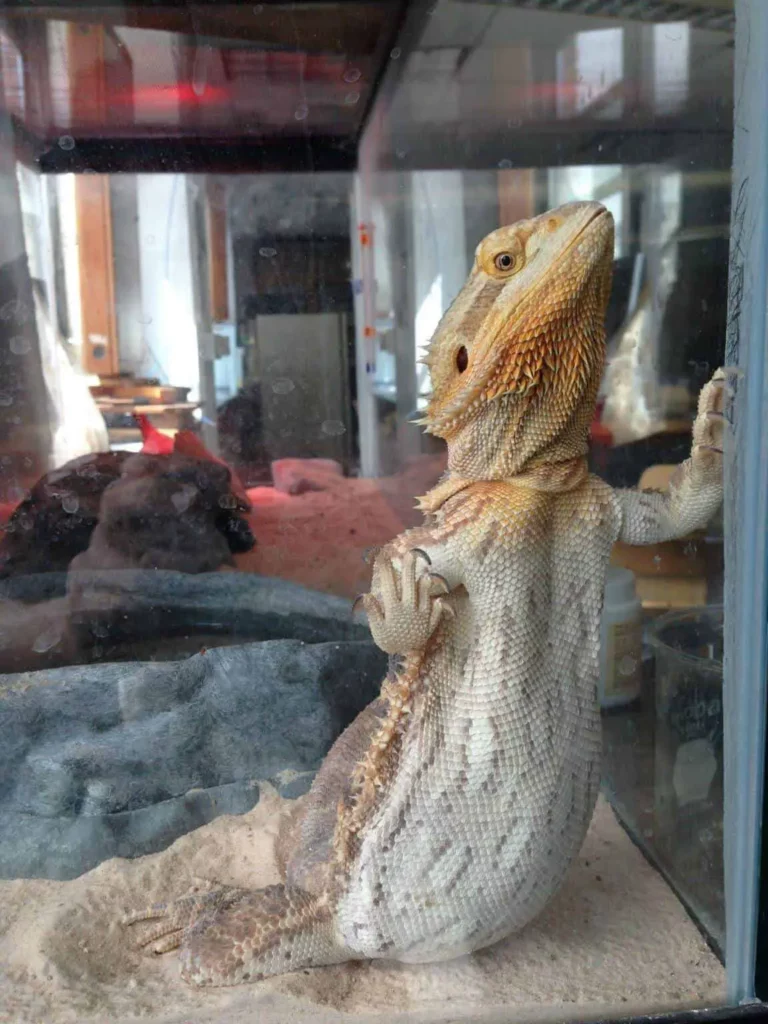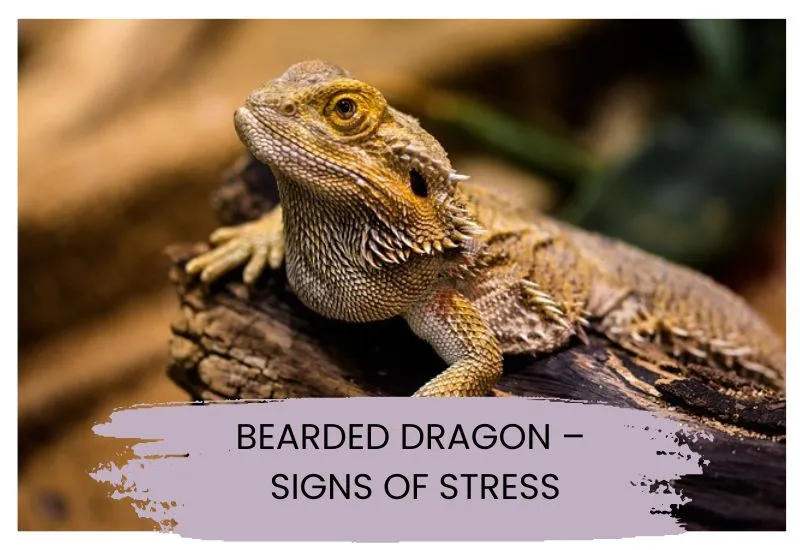Bearded dragons are popular pets known for their unique personalities and relatively easy care. However, like all animals, they can experience stress, which can impact their health and happiness. It’s important for owners to recognize these signs of stress, understand their causes, and know how to alleviate them. This article will guide you through each of these aspects.
Key Stress Signals in Bearded Dragons: What to Look Out For
Changes in Colouration
Bearded dragons display darker color changes, especially near the chin or beard, when stressed.

Appetite Loss
A sudden decrease in appetite or refusal to eat can be a sign that your bearded dragon is experiencing stress.
Stress marks
If a bearded dragon’s belly has dark markings resembling tiger stripes, oval shapes or dark lines, it is likely that the dragon is stressed. Sometimes these markings can also be found on their limbs or chin.

Reduced Activity Levels
If your normally active bearded dragon becomes lethargic or less interested in its surroundings, it may be a sign of stress.
Basking Behaviour Changes
Changes in basking habits, such as spending too much or too little time under the basking lamp, can indicate stress.
Aggressive or Defensive Behaviour
A stressed bearded dragon may become more aggressive or defensive, showing behaviors such as hissing or puffing up.
Frantic Movements or Clawing at the Vivarium
If your dragon is trying to escape its enclosure or showing signs of restlessness, it could be stressed.

Now that we have covered some classic signs of stress let’s talk about how to understand what could be causing it in the first place.
Why is Your Bearded Dragon Stressed?: Understanding the Causes of Stress
Understanding and interpreting your bearded dragon’s signs of stress is vital for fostering and looking after your scaly companion. Identifying the root causes of their anxiety not only promotes their general health but also enhances your relationship with them.
However, it’s important to recognise that identifying what’s causing your bearded dragon to feel stressed can be challenging. We have created a useful chart that links typical symptoms of stress to their probable sources. This chart is based on extensive research and is intended to assist rather than replace professional veterinary advice.
| Signs of Stress | Possible Causes of Stress |
|---|---|
| Changes in Colouration | Health Issues: Illness and Injury, Reflections Causing Distress |
| Stress marks | Newly acquired bearded dragons, getting used to their new environment |
| Appetite Loss | Dietary Concerns and Changes, Environmental Factors |
| Reduced Activity Levels | Health Issues: Illness and Injury, Inadequate Temperature and Humidity Levels |
| Basking Behaviour Changes | Incorrect Tank Size, Poor Lighting and Lack of UVB Exposure |
| Aggressive or Defensive Behaviour | Cohabitation and Territorial Issues, Handling and Interaction Stress |
| Frantic Movements or Clawing at the Vivarium | Noisy or Chaotic Surroundings, Inadequate Temperature and Humidity Levels |
Environmental Stress Triggers for Bearded Dragons
Wrong Temperature and Humidity Levels
The temperature and humidity of the vivarium are critical to the health of a Bearded Dragon. Inappropriate temperatures, especially if too cold or fluctuating, can cause stress and health problems. The ideal temperature range for a bearded dragon’s vivarium should be between 22-26 degrees Celsius on the cool side and 38-42 degrees Celsius in the basking area. Humidity should be maintained between 30-40%. Regular monitoring and adjustment is necessary to ensure that these conditions are consistently maintained. Learn more about all aspects of bearded dragon care in out in-depth guide.
Incorrect Vivarium Size
A vivarium that’s too small can cause stress due to the lack of space for movement and exploration. As bearded dragons grow, their space requirements increase. A fully grown bearded dragon typically needs a vivarium that’s at least 183 cm in length, 61 cm in width, and 61 cm in height. Providing an appropriately sized vivarium is crucial for their physical and mental wellbeing. Find our recommendation on the best bearded ragon vivariums in this guide.
Poor Lighting and Lack of UVB Exposure
UVB lighting is essential for bearded dragons to synthesise vitamin D3, which is vital for calcium absorption and overall health. Lack of adequate UVB lighting can lead to stress and serious health problems such as metabolic bone disease. It is important to ensure that your Bearded Dragon has access to adequate UVB lighting for approximately 12-14 hours per day.
Noisy or Chaotic Surroundings
Bearded dragons can be sensitive to their environment. Loud noise, frequent disturbance or a chaotic household can cause stress. It’s important to place their vivarium in a quiet and peaceful area of the house, away from traffic and noise, to create a peaceful environment for them.
Behaviour-Related Stress Factors
Mating Season Challenges
During the mating season bearded dragons may show signs of stress due to hormonal changes. Males may become more territorial and aggressive, while females may show signs of restlessness. Understanding and accommodating their behavioural changes during this time is crucial to managing stress.
Cohabitation and Territorial Issues
Bearded dragons can become stressed if kept with other reptiles. Territorial disputes and competition for resources such as food and basking sites can significantly increase stress levels. It’s generally recommended that bearded dragons are housed separately to avoid these problems.
Reflections Causing Distress
Sometimes Bearded Dragons can become stressed by their own reflections in the glass of their vivarium, mistaking it for another dragon. This can lead to persistent scratching of the glass or aggressive posturing. Using backgrounds on the sides of the vivarium or adjusting the lighting can help minimise reflections and reduce stress.
Handling and Interaction Stress
While some bearded dragons tolerate handling well, others may find it stressful, especially if done frequently or improperly. It’s important to understand and respect each dragon’s individual preferences. The RSPCA provides a helpful guide on handling bearded dragons, which can be found here, offering insights into minimising stress during interactions.
Health-Related Causes
Illness and Injury
Health issues, whether due to illness or injury, are a common cause of stress in bearded dragons. Symptoms like lethargy, irregular eating, or physical abnormalities should prompt a consultation with a reptile veterinarian. Early detection and treatment of health issues are crucial for reducing stress and ensuring their well-being.
Dietary Concerns and Changes
An improper diet or sudden changes in diet can cause stress and health problems in bearded dragons. A balanced diet, appropriate for their age and health status, is essential. Sudden changes in their diet should be avoided or introduced gradually to prevent stress.
How to Prevent and Reduce Stress in Bearded Dragons
Creating a comfortable and stress-free environment for bearded dragons involves several key aspects, from optimizing their habitat to ensuring proper diet and handling. By proactively addressing these areas, owners can significantly enhance the quality of life for their bearded dragons, promoting both physical health and emotional well-being.
Creating an Appropriate Environment
Ensure that the enclosure is the right size and offers a proper temperature gradient, humidity levels, and UVB lighting. This creates a comfortable and stress-free habitat.
Regular and Appropriate Feeding
Provide a balanced diet suitable for their age and health condition. Regular, predictable feeding can reduce stress significantly.
Ensuring Quiet and Calm Surroundings
Place the enclosure in a quiet area of your home where there’s less foot traffic and noise.
Handling Techniques and Frequency
Understand your dragon’s temperament and adjust the frequency and method of handling accordingly. Some may prefer minimal handling.
Enrichment Activities and Tank Decor
Offer enrichment such as climbing structures, hiding places, and suitable toys to stimulate their minds and reduce stress.
When to Seek Professional Help
Even with the best of care, there may be times when a Bearded Dragon’s stress symptoms are indicative of more serious problems that require professional intervention. Knowing when to seek help from a reptile vet is vital for the health and well-being of your pet.
While some signs of stress can be resolved by changes in care and environment, certain symptoms may indicate underlying health problems. These include prolonged loss of appetite, persistent aggressive behaviour, noticeable weight loss or signs of physical illness such as lesions or abnormal faeces. If these symptoms persist despite environmental and dietary adjustments, it is time to consult a professional.
A vet can provide a thorough health assessment, diagnose any underlying problems and recommend appropriate treatments. They can also offer advice on care and stress management specific to your bearded dragon’s needs. Regular health checks can prevent potential stress-related health problems and ensure that your Bearded Dragon is in optimal health.
Conclusion: What we’ve Learned About Stress in Bearded Dragons
Understanding and addressing the signs of stress in bearded dragons is crucial for their wellbeing. By creating a suitable environment, providing appropriate care, and being attentive to their needs, you can ensure a happy and healthy life for your pet. Remember, a stress-free bearded dragon is a happy and healthy companion.
Frequently Asked Questions
How Long Do Stress Marks Last in Bearded Dragons?
Stress marks, typically seen as darker, more pronounced markings on a bearded dragon’s underside, can vary in duration. If the stressor is removed or adequately managed, these marks should fade over time. However, if they persist, it may indicate ongoing stress or other health issues.
Can Stress Lead to Long-Term Health Issues?
Yes, prolonged stress can lead to long-term health issues in bearded dragons, including weakened immune systems, behavioural problems, and an increased risk of illness. It’s important to address stress promptly to prevent these long-term effects.
Are Baby Bearded Dragons More Prone to Stress?
Baby bearded dragons can be more prone to stress due to their smaller size and vulnerability. They require careful handling, a well-maintained environment, and proper nutrition to minimize stress during their crucial early stages of development.
